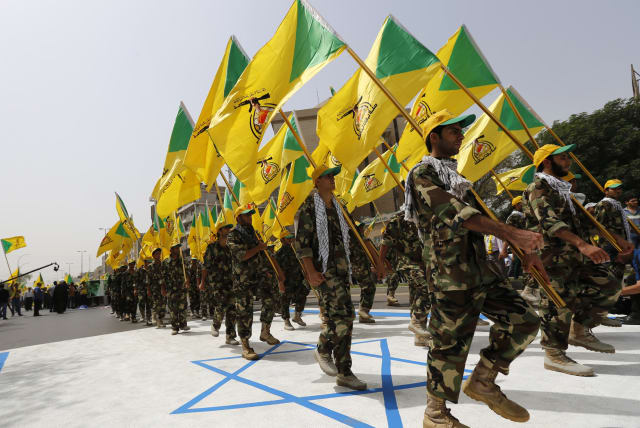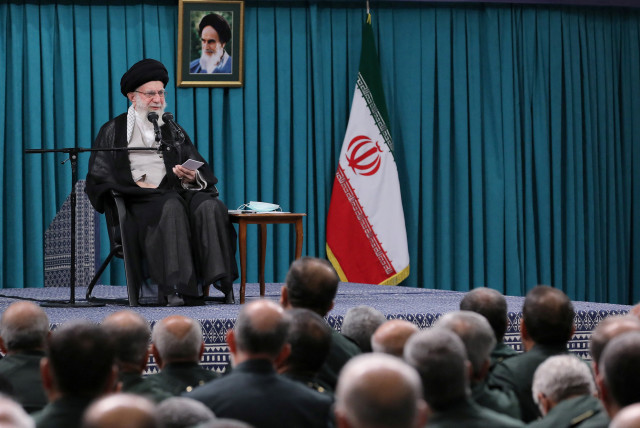Iran’s ‘attack and demand ceasefire’ doctrine plays out in Iraq

The Iranian policy with Kataib Hezbollah is similar to its policy with Hamas after the massive unprecedented attack on Israel on October 7.
The Iranian-backed terrorist group Kataib Hezbollah allegedly was behind the drone attack that killed three US service members in Jordan on Saturday. The US is expected to respond.
On Tuesday, Kataib Hezbollah said it would pause attacks on US forces. In response, the Pentagon said: “Actions speak louder than words.”
The Iranian policy with Kataib Hezbollah is similar to its policy with Hamas after the massive unprecedented attack on Israel on October 7. Iran carries out attacks, either directly or via proxies, and then immediately wants a ceasefire.
This has also been Hamas’s doctrine for decades. Hamas attacks whenever it chooses, and then it demands a pause in fighting or a ceasefire. In the past, this was characterized as a hudna, or long-term ceasefire.
The concept is kind of obvious when one thinks about it. A terrorist group’s goal is to defeat an adversary or massacre all of its members. But the group isn’t strong enough to achieve this in one large conventional battle, so it thrives off killing a few people, kidnapping a few, and then demanding a hudna, followed by regrouping and then killing more and getting a new hudna. Rather than a hudna, it could be described as “death by a thousand paper cuts” strategy.
Long term goals
Essentially, Kataib Hezbollah has been doing this for more than a decade. It’s previous leader, Abu Mahdi al-Muhandis, was a longtime Iranian proxy and terrorist in the region. Like all Iranian-backed groups, however, Kataib Hezbollah’s goals were long-term. Its goal is to remove the US from Iraq and from other places in the Middle East, just as Hamas’s goal is to destroy Israel.
Kataib Hezbollah is no match for the US military, however, if the US military actually wants to fight it. Therefore, the group carries out a series of small attacks, driving up the “price” for the US remaining in the region. Whenever Kataib Hezbollah senses the US will retaliate, it pauses operations and demands a ceasefire.
Iran is very good at spreading its narrative in this regard. It will encourage a group such as Kataib Hezbollah to escalate and kill Americans in a place like Jordan. Then it depicts any US response as “widening the war.”
Similarly, Hamas carried out a huge massacre on October 7, but then it depicted Israel’s actions in Gaza as somehow disproportionate or escalating the war.
At each juncture, Iran is the one escalating. It encouraged Hezbollah to fire 2,000 rockets at Israel since October 7, but any Israeli response “risks” a “wider war.” Tehran even appears to have spread this talking point in the wake of the January 27 attack on US forces in Jordan. Any US response is a “risk” and could mean “wider war.”
Kataib Hezbollah has now “paused” its attacks, so it will portray itself as the victim if its members are targeted. The US will be portrayed as violating the “ceasefire” that Kataib Hezbollah invented.
The process of how Iran and its proxies conduct themselves is entirely transparent. They often create layers of feigned complexity for their actions. For instance, pro-Iranian politicians in Iraq are now trying to get US forces to leave Iraq. Therefore, the Iranian lobby asserts that any US retaliation to Iranian proxies’ unprovoked attack on US soldiers in Jordan could cause Iraq to demand that US troops leave Iraq.
Think this through carefully: The US sent troops to Iraq after 2014 to help Iraq defeat ISIS. Pro-Iranian groups began attacking US forces in Iraq in 2019. The US responded to those attacks in January 2020. In response, Iran attacked US forces in Iraq.
Beginning in January 2021, the Iranian proxies in Iraq escalated attacks in Iraq to also target US forces in Erbil in the autonomous Kurdistan Region. Around 90 attacks were carried out between January 2021 and October 6, 2023. After October 7, Iran had its proxies carry out more than 160 attacks on US forces in Iraq and Syria. This culminated in the January 27 attack in Jordan, expanding the war on the US.
After hundreds of attacks, one Iranian proxy now claims it will stop the attacks. Clearly, Iran has dictated every step of this process. The question is whether the US will call the Iranian bluff this time and get beyond the cycle of “Iran attacks and demands a ceasefire immediately,” which is the guiding doctrine of Iran in the Middle East.
Jerusalem Post Store
`; document.getElementById("linkPremium").innerHTML = cont; var divWithLink = document.getElementById("premium-link"); if (divWithLink !== null && divWithLink !== 'undefined') { divWithLink.style.border = "solid 1px #cb0f3e"; divWithLink.style.textAlign = "center"; divWithLink.style.marginBottom = "15px"; divWithLink.style.marginTop = "15px"; divWithLink.style.width = "100%"; divWithLink.style.backgroundColor = "#122952"; divWithLink.style.color = "#ffffff"; divWithLink.style.lineHeight = "1.5"; } } (function (v, i) { });

